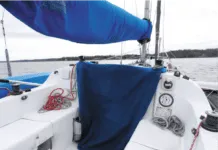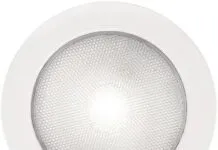Dodging a Bullet When Caught on Bulkhead
The following is aimed primarily at boats that are unable to leave an alongside dock or bulkhead before wind and seas become dangerous. Any fetch beyond 200 yards is dangerous, and there may be nothing you can do to protect the boat. However, if you are in a protected marina, well up a creek, and the storm is moderate, these actions can help. Just remember that low breakwaters will be overtopped, wooden breakwaters fall apart, other boats will come loose, and there will be lumber in the water from broken docks.
Make Your Own Rugged Fender Boards
We described a simple home-built version several years ago (Practical Sailor, December 2011); here we present a few simple upgrades on the same basic design, allowing for simpler deployment, better fender retention, and more stable positioning. Pressure treated lumber provides inexpensive durability.
Make A Tie-down Strop
After hundreds of years of seafaring, there shouldnt be any new rope tricks. Then new high-strength materials like Amsteel came along, suggesting new applications for old-school knot craft. The age-of-sail strop morphed into the versatile the soft shackle (see Going Soft on Shackles, April 2015). Racing sailors employ it to eliminate weight aloft, and cruisers like the economy and versatility. Weve found good uses for soft shackles on jib sheets and ground tackle, but the strop is also alive and well, securing tarps and gear. The best part is you can make them from old rope, costing nothing.
DIY Fishing Gear for Sailors
We reviewed clamp-on rod holders a few years in the past, but found them expensive (see PS October 2006). Fortunately, there are alternatives that can save hundreds of dollars and be installed in an afternoon. Less shiny, but functional.
Simple Sail Repair
Often an old sail wont hold stitches, and some sailors hate to sew. A number of products proved strong enough and flexible enough to make serviceable repairs. In Stitch-free Sail Repair, (see November 2017) we reviewed repair tapes, epoxy, polyurethane, and a few other common adhesives for usefulness as no-sewing options for sail repair, and in September 2017 we reviewed options for Sunbrella repair. After two years in the Maryland sun, the rankings have changed…
Make a Mini Dodger
A companionway slider and hatch boards are the most common type of cabin entry on sailboats. Its seaworthy, lightweight, and inexpensive. Unfortunately, you can't leave the hatch open when its raining without getting water below. Swapping the hatch boards for a hinged door is a popular upgrade, but in many boats there simply isn't space for an opened door.
Reliable Chain Connections
We often get asked about joining two shots of chain together without compromising strength. You have a number of options-including some that are just plain bad. The important thing is to make sure the connector is of the highest quality and that it matches or exceeds the strength of your existing chain.
Carving Out Cores
A modified roofing nail is perhaps the most versatile tool for removing core when sealing fastener holes. It is much easier to control than bent nails or cut-down allen keys, which can jump around as they spin. Core removal is more uniform. Wood chips are finer and easier to remove. It is faster than a Dremel cutter and undercuts twice as far.
Elastic Mooring Systems
When Hurricane Irma plowed through the Florida Keys, it left behind both a trail of destruction and a wealth of information for us to learn from. One of the most instructional episodes took place at the municipal mooring field at Boot Key in Islamorada.
Screw types prove their mettle in load testing.
The mechanics at work at the other end of your mooring line matter as much as the mooring line and pendant. In 2009, Practical Sailor reported on two pull tests held 12 years apart (See Mooring Anchors for Sensitive Seabeds, Practical Sailor August 2009). We also reported on the results of a third test being carried out by contractors for the City of Sarasota, which at that time was about to become one of Floridas seven pilot mooring fields. Boot Key Mooring Field, which took a near direct hit from Hurricane Irma in 2017, was another harbor participant in the program (see adjacent article).


















































